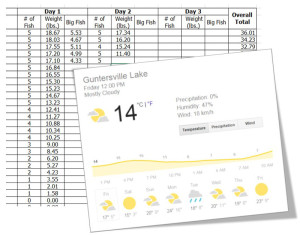 Although my multi-day tournament experience is limited, I’ve been reading a fair bit on what the pros have to say about fish management and other strategies that I want to get down in words for future use. Single day events are somewhat easier in this regard – go out and catch as big a bag of fish as possible. In some tournaments finding five fish will give you a good shot at the money, in others, five fish without a solid (one or two or more) kicker(s) (a bigger fish relative to the norm in the water body you’re fishing) will leave you out of contention. Strategies for targeting bigger fish vary. Going for a limit first and then concentrating on upgrading was the norm in the past and still has some merit in the right situations. However, at the higher tournament levels the opposite is now more in favour – go find big fish first thing, while the bite is generally better in the morning, then work to fill a limit out later in the day. Once the limit is filled, go back to targeting larger fish. At the higher levels a limit without those large kicker fish will likely leave one out of the money.
Although my multi-day tournament experience is limited, I’ve been reading a fair bit on what the pros have to say about fish management and other strategies that I want to get down in words for future use. Single day events are somewhat easier in this regard – go out and catch as big a bag of fish as possible. In some tournaments finding five fish will give you a good shot at the money, in others, five fish without a solid (one or two or more) kicker(s) (a bigger fish relative to the norm in the water body you’re fishing) will leave you out of contention. Strategies for targeting bigger fish vary. Going for a limit first and then concentrating on upgrading was the norm in the past and still has some merit in the right situations. However, at the higher tournament levels the opposite is now more in favour – go find big fish first thing, while the bite is generally better in the morning, then work to fill a limit out later in the day. Once the limit is filled, go back to targeting larger fish. At the higher levels a limit without those large kicker fish will likely leave one out of the money.
So how does one target kicker bass only? Some possibilities include(1) (but are certainly not limited to):
- Larger bass generally hold on the biggest pieces of structure – concentrate on them and move quickly past the rest.
- Larger bass are more likely to be on their own – fish isolated pieces of cover.
- Use larger baits with bulky profiles.
- Bigger fish get that way because they have learned to avoid common lures – downsize or go for finesse (i.e. the complete opposite of the previous point!).
- Scattered big fish can be heart-breakers. One or two fluke kickers caught in practice may lead to the use of a unwinning pattern come tournament day. It is also possible the pattern has changed since then. Know when to cut your losses.(2)
In multi-day events the idea of fish management comes into play. Spots that only hold a certain number of fish and don’t replinish may need to be managed, taking only enough fish on earlier days in the tournament so that the spot will hold up on the final day. For example, Dave Hite will take a limit that he feels will keep him in contention and then leaves them for following days.
On the other side of this debate is Kevin VanDam. While recognizing the need to manage fish on certain occasions, KVD prefers to hammer the bass. The thought is to catch as many and as much as possible to add to your weight. Find new fish elsewhere, have multiple areas in play and multiple backup plans. The fish may not be in the same spot next day anyway, or a front may shut everything down(3).
While recognizing the need to manage fish on certain occasions, KVD prefers to hammer the bass.
Further points to consider:
- A good spot may hold up for a day or two. A good pattern, one that can be applied in multiple areas of the lake, is vastly superior.
- Always be ready to change things up if weather and/or water conditions change. Changes in behaviour may be subtle, act accordingly. Don’t keep doing what’s not working just becuase it worked yesterday.
- Backup plans are even more important in multi-day tournaments especially as conditions change. Remember plan B (or C or D…) could include a change in technique (power to finesse – finesse to power) or location or both.
Tournamnent fishing is as much a mental game is it is about technique. Prepare yourself.
References:
1) M. Hicks, “Kicker Strategies” B.A.S.S. Times, March 2016, 30-32.
2) M. Hicks, “The Teaser Bass Trap” B.A.S.S. Times, February 2016, 36-39.
3) M. Hicks, “Killer Closers” B.A.S.S. Times, March 2016, 38-41.


